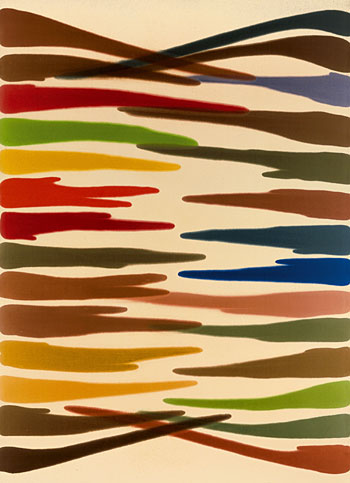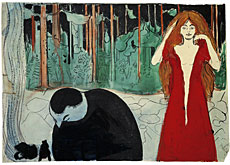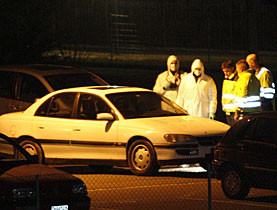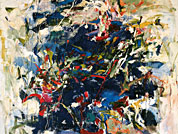Beyeler shows painting in motion

The Beyeler Foundation is hosting a huge exhibition on action painting – a dramatic form of abstract art in which paint is thrown, splattered or poured onto the canvas.
On display at the museum at Riehen near Basel are several works by its most famous proponent, American artist Jackson Pollock. In total, the exhibition brings together more than a hundred paintings from all over the world.
The term action painting was coined by United States art critic Harold Rosenberg in 1952 to characterise the work of a group of American Abstract Expressionists.
The style had been around in the US since the end of the Second World War. Over the following 20 years it spread worldwide.
Seen as a reaction to the tragic events of the early 20th century, action painting challenged traditional conceptions of art, promoting a freer and more immediate style. It was considered somewhat revolutionary at the time.
For action painters this spontaneous type of painting allowed the artist’s personality and state of mind to be directly transmitted to the work.
It often involved the artist moving around on or standing in the middle of a canvas set on the floor, letting the paint spatter downwards. For many exponents, the act of creating was more important than the finished product.
By putting the works of 27 international artists side by side in the exhibition, the Beyeler Foundation is not only aiming to show the lesser-known aspects of action painting, but also the development of this influential 20th-century avant-garde movement.
“The exhibition is not only important because of the great works shown here,” said Sam Keller, the Beyeler’s new director.
“But also because US and European artists are shown together or next to other artists such as the South American Roberto Matta or the Japanese Kazuo Shiraga, showing how action painting was an international, global artistic movement.”
European roots
Although action painting is normally thought of as American, the exhibition is keen to show that the style had European roots as well.
The works of the German artists Hans Hartung (1904-1989) and Wols (1913-1951) show how they were influenced by the Surrealist idea of automatism, a technique used to express the creative force of the unconscious in art.
Space is also given to the large body of European-born artists who emigrated to the US and who contributed to action painting’s development.
The Armenian Arshile Gorky (1904-1948) for example developed his unique gestural style, resulting in works of a poetic and expressive nature. One such work is Waterfall (1943), in which amorphous shapes and drips of liquid paint suggest the fluidity of the water.
Also shown is the German Hans Hofmann (1880-1966), who came to New York in 1932 and founded the Hans Hofmann School of Fine Arts, which trained a generation of artists.
Jackson Pollock
Among them was Jackson Pollock (1912-1956), who learnt the “dripping” technique from Hofmann. This style, along with “pouring”, can be widely seen in the 14 works by Pollock on display.
The selection includes important paintings such as Out of the Web (1949) or Number 7 (1950), showing the full range of his expressive devices. These form the core of the exhibition.
“The last large exhibition showing Jackson Pollock paintings was last century at the [Museum of Modern Art] in New York and at the Tate in London,” said Keller. “It’s rather rare for these works to be shown, also because their conservation is not easy.”
“It will be some time before they are shown again in our area. They are spectacular, large-scale works and transporting them and exhibiting them is really a great challenge.”
swissinfo, based on an Italian article by Paola Beltrame in Riehen
The exhibition runs until May 12, 2008. Among the artists represented are Jackson Pollock, Arshile Gorky, Wols, Morris Louis, Sam Francis, Pierre Soulages and Lee Krasner.
The Action Painting exhibition is accompanied by a monumental work by John M Armleder in the basement – Grifola Frondosa (3 x 15 metres, 2006) – which sets up a dialogue with the gestural paintings in the show.
Films made concurrently with the paintings which provide insights into the artists’ working methods are also part of the display.

In compliance with the JTI standards
More: SWI swissinfo.ch certified by the Journalism Trust Initiative



You can find an overview of ongoing debates with our journalists here. Please join us!
If you want to start a conversation about a topic raised in this article or want to report factual errors, email us at english@swissinfo.ch.